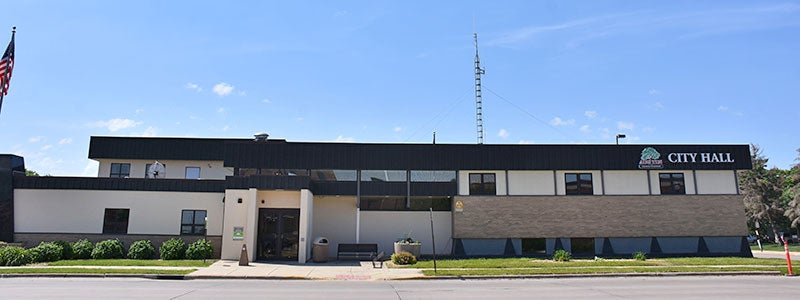Two perspectives on proposed tax levy increase: City, Chamber of Commerce on opposite sides of issue
Published 10:57 am Saturday, September 1, 2018

- Austin City Hall and other city entities will begin opening Monday. Herald file photo Herald File Photo
Editor’s note: This is the first of a two-part series looking into the proposed tax levy for the city of Austin.
Read the second part here: Small businesses may take brunt of levy hike
The Austin City Council has been discussing the 2019 budget, and expenses are calling for a $932,000, or 15.7 percent, increase in the tax levy.
The increase comes as the city plans to budget $500,000 for a compensation/ classification study it hopes to implement next year. Other increases come from contractually obligated pay increases, a $200,000 housing initiative and funds committed to the new Community Rec Center.
“Our primary driver, with 62 percent of our budget being personnel, is cost of living increases and the compensation and classification study,” said City Administrator Craig Clark. “A lot of our peer cities have done comp and class studies multiple times, while we haven’t even done one. We’re well overdue for having done one of those.”
But for Austin Area Chamber of Commerce Director Sandy Forstner, the consistency with which the city has increased the tax levy over the past few years is concerning.
“Our main concern with this proposed levy increase is that it will be close to a 60 percent increase in the span of four years,” he said. “That’s pretty significant. The rate of inflation over that same period of time has been eight percent, so it’s taking a bigger chunk out of property owners’ check books.”
The city raised the tax levy by 13.6 percent in 2016 while 2017 and 2018 saw increases of 9.6 percent each.
Property taxes are based on valuation and the classification of the property. If the property valuation goes up at the same time the levy goes up, property owners can find themselves paying a larger percentage.
According to Administrative Service Director Tom Dankert, a 15.7 percent increase in the tax levy would mean the following increases for 2019:
• $101,400 home valuation = $60 increase
• $124,600 home valuation = $80 increase
• $187,500 home valuation = $136 increase
• $227,000 home valuation = $171 increase
• $281,500 commercial valuation = $396 increase
• $347,300 commercial valuation = $503 increase
• $997,900 commercial valuation = $1,558 increase
In 2018, the city adopted a tax levy of $5,941,000, a 9.6 percent increase from 2017. The city initially proposed a $1,039,000, or 17.9 percent, increase in the tax levy for 2019; however, the city council agreed to a few reductions to bring it down to 15.7 percent at its most recent work session meeting,
“What we’re seeing in general for cities across the state are, as far as expenses go, nothing seems to be getting any cheaper,” Clark said. “They are seeing inflationary pressures. There isn’t anything we relish about increasing the levy. Each item we look at has to stand on its own two feet. The council gives a very thorough scrubbing of each item on the list. There has to be a reason and justification for it, and if it isn’t needed, we don’t do it.”
Clark pointed out that Austin is consistently rated among the lowest taxed cities in the state when compared to similar sized communities. By comparison, Albert Lea had a 2016 tax levy of $6,156,598 to Austin’s $4,994,597, according to the Minnesota State Auditor’s website. Faribault’s 2016 tax levy was $7,503,832, while Owatonna’s was $10,567,982.
“That’s something we’re certainly happy about,” Clark said. “We try to be as frugal as possible.”
While acknowledging tax rates in Austin are low compared to other Minnesota cities, Forstner believes more can be done to lower the tax levy, saying that the tax levy has doubled since 2010 and that the city has surpassed the county in the percentage of taxes received.
“If this (levy) was a one time deal, it wouldn’t be as big, but this is four consecutive years of double digit increases,” he said. “The council has decided to increase spending in a variety of ways and we think that is an excessively high rate. Nobody’s income has gone up, but they’re asking taxpayers to pay more. We think they can reduce the levy with due diligence and budget cutting.”
Forstner also noted that Austin ranks among the highest in recipients of Local Government Aid (LGA). In 2018, Austin received $8,151,133 in LGA, ranking sixth in the state out of 867 listed communities. Minneapolis, St. Paul, Duluth, Winona and St. Cloud were the only communities to receive more total dollars.
But while LGA plays a significant role in the city’s budget, Clark said the city has been petitioning the legislature to increase LGA to the higher 2002 levels as a means of alleviating inflationary pressure.
“Each year puts added pressure on local taxpayers and that’s why we try to make our case to the legislature that an LGA increase is necessary to mitigate the impact on those costs that cities see across the state,” he said.
Another concern for Forstner is the effect consistently raising the tax levy will have on commercial industrial property owners.
“When you’re a residential property owner, you get a homestead credit, but commercial industrial property has the highest tax rate. Compared to some classes, it’s as high as 3 ½ to 4 times more,” he said. “We as a business organization believe that you can grow an economy by growing businesses because they are the ones that create jobs. Every time an additional burden is placed on them, their ability to grow is reduced. It’s not just the city levy; it’s other taxes, like state taxes and county taxes.”
When asked if the city had concerns about the effects on business, Clark said, “Absolutely.”
“One of the things we advocated for was business property tax relief for those small businesses that would be exempt from the first $150,000 of the commercial industrial property value,” he said. “These are your Main Street type businesses rather than your large businesses. We advocated for that and in 2017, (the legislature) passed an exemption for the first $100,000. That was an important acknowledgment that Main Street businesses do carry a heavy load. Our state legislature, however, set that classification rate for the commercial industrial taxes. That’s not something the City of Austin has control over.”
“We have recruitment packages we send out to companies to try to promote economic development,” he added. “Nobody has come back to us and said, ‘Your taxes are too high, so we’re not going to locate in Austin.’”
Forstner also expressed opposition to two particular items in the budget: the compensation/classification study and the housing initiative.
“In this entire formula, other than the rec center, there is no increase in services,” he said. “It’s the same levels of services with higher levels of compensation. In this particular levy increase, there is $500,000 for a comp and classification study that has yet to be reviewed and implemented. They’re anticipating that; it could be higher, it could be lower. It’s premature to levy when you don’t know the cost, so we’re asking them to consider not levying for that in 2019 and waiting for the following year. Another thing I suggest is that they look at the $200,000 set aside for the housing initiative. There is not a project; it’s basically $200,000 to accumulate over the successive years into a fund that is sufficient to attract a housing development project. The reason Austin gets so much LGA is because, as an overall community, we have a low tax capacity. There are a number of reasons for that, primarily older housing. “
Clark, however, said the compensation/classification study is necessary to make Austin a competitive employer.
“We don’t go too far and hear challenges in the business community about unemployment rate being so low and being able to find quality workers,” he said. “The City of Austin is a significant employer as well, and we want to make sure we have qualified people to fill the positions to serve the public. We also want to be fair to our employees serving the public and make sure we compensate them equitably and appropriately. With the comp and classification study, we’ve delayed that and we’ve seen some challenges with our employees because of that. It doesn’t serve the City of Austin’s interest to lose an employee because we’re not competitive on pay. People are going to come and go naturally on some extent, but if we’re losing them on pay, the question is whose going to replace that person and will they be unsatisfied over time because of the compensation and leave as well? The cost of turnover and hiring and training, those are all things that we consider. We don’t know what the study is going to come back with, but we want to be planning appropriately, so we budgeted $500,000 for that. That certainly will come back to council for approval, but knowing that that will most likely be the first part of next year, we want to have those resources in the budget to accommodate that.”
Clark also mentioned that building more market rate houses in the city is key to lowering the tax levy.
Despite their different position, Forstner and Clark agreed it is a difficult process.
“This is a public process,” Clark said. “When the council started in the budget process, we said we liked what we did last year, that’s our baseline, and does anyone have anything that they want us to stop? Let us know. There haven’t been many folks at the open discussions saying, ‘My taxes are heavy, could you please consider cutting out x, y or z?’ We’re here to hear that too. We’re trying to balance the interest of the community.”
“Everybody has the best interest of the city in mind,” Forstner said. “We understand that in this economy it is hard to attract and maintain employees. But, we believe the levy is making it harder for the private sector and we would like to see the levy increases in the single digits rather than the double digits.”





